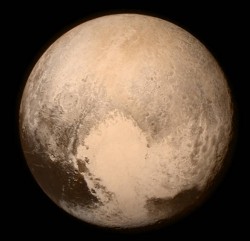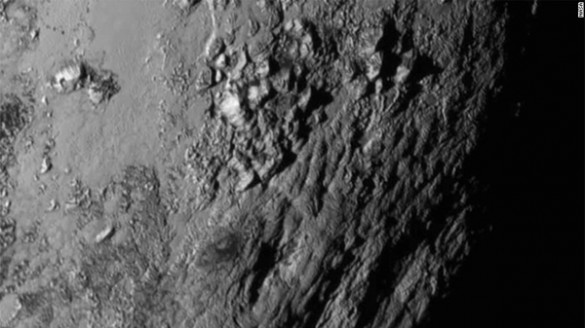
Last Tuesday morning, July 14, after traveling nearly 3 billion miles, the New Horizons spacecraft flew within 800,000 miles of the planetary pair Pluto and Charon … madly snapping pictures as it zipped past.
In the strange fashion of space encounters, particularly those in the outer reaches of the solar system, the flyby was something of a non-event here on Earth. That is because it takes more than four hours for radio signals to travel from Pluto to Earth. In addition, the spacecraft was so busy collecting data as it flew past the twin planets that it didn’t begin transmitting images back to Earth until well after its close encounter.

Furthermore, New Horizons was equipped with a large onboard memory so it could rapidly collect a lot of data. However, to save money the radio transmitter was designed to send this information back at a very low data rate. As a result, the images began trickling in on Wednesday and will continue coming for more than 16 months.
None of these factors dimmed the excitement or the significance of the once-in-a-lifetime event for David Weintraub, professor of physics and astronomy, who is an expert on Pluto, having written a popular book about it in 2008 titled “Is Pluto a Planet?: A historical journey through the solar system.”
The feature that particularly caught his eye in the first, high-resolution images streaming back to Earth were the mountains.

“The ice mountains are spectactular,” he said. “[rquote]Pluto wasn’t supposed to have enormous mountains.[/rquote] Of course, ‘supposed to’ implies that we, planetary scientists, already have all the answers, but the incredible mystery of going where we’ve never been before is that we know that we don’t have all the answers and that we’ll be surprised. In fact, we know that and that’s one of the reasons why exploring Pluto is so exciting.”
Pluto’s mountains were unexpected because mountains require some process to build them. On the Moon, the mountains are the rims of impact craters. On Mars, the mountains are all volcanic, the result of internal heat working its way out of the planet. On Earth, our mountains emerge from plate tectonics and volcanic activity. On Jupiter’s moon, Io, tidal heating from the giant planet does the trick.
“On Pluto? There can’t possibly be enough internal heat sources, after 4.5 billion years, to generate volcanic activity. There can’t possibly be tidal heating from Charon. The mountains don’t look impact-generated.
“So what made them? Maybe they’re leftovers from when Pluto formed? Maybe Pluto is so cold that the ice-mountains that formed billions of years ago haven’t had time to relax. Or maybe Pluto isn’t billions of years old? Whatever the answers are, [lquote]Pluto is a cold mystery waiting to be solved[/lquote],” Weintraub said.
“And with the data only beginning to trickle in, I don’t even know what most of the questions are yet!
“Pluto is a different kind of object than any other kind of object we’ve ever studied in the solar system. It is guaranteed to teach us things about planetary physics that are not yet in the textbooks.”
Recently Weintraub wrote an essay for The Conversation about the New Horizons mission and was interviewed by the editor of RedOrbit:

New Horizons: Journeying to Pluto and Beyond, Part 1
New Horizons: Journeying to Pluto and Beyond, Part 2
New Horizons: Journeying to Pluto and Beyond, Part 3
RedOrbit, 8-10 July 2015
“NASA missions may re-elevate Pluto and Ceres from dwarf plants to full-on planet status”
The Conversation (25 Feb 2015)